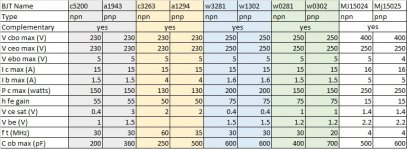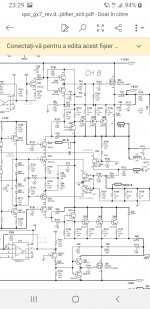Unfortunately, not all manufacturers provide those Ic - Vce curves.
I made some corrections in the table. I made typo in one transistor, I do have NJW0281 (not 0381 like I typed). So I do have this complementary pair. I suppose I may use the pair used in Pioneer A-09 and see.
I made some corrections in the table. I made typo in one transistor, I do have NJW0281 (not 0381 like I typed). So I do have this complementary pair. I suppose I may use the pair used in Pioneer A-09 and see.
Attachments
Now if you're in love with both diamond buffer and no global feedback there's hardly a better design (except Accuphase'a of course) than the one in Pioneer A-09 brought to our attention by Ciufolli.
Thanks for the info about the Altmann's web page, yes, that's what I have seen in the past.
That Pioneer A-09 is a beast.
But both of these approaches are only half of the solution. Even they do not use global negative feedback between the input and output transistors, in Altmann's case, there is still feedback up to the driver/and or one first output.
I do want to pursue independent buffer, stand alone, in conjunction with independent pre, stand alone. Pre without global negative feedback too. I am running my buffer in main system now and its the best sound I achieved so far. Yes, I used M2, F3, F5, F1J, AlephJ, Goldmund, Dartzeel, Sanyo Plus, and many chip based. My buffer sounds better than F4 to me for some reason. Its the 3d soundstage I never heard before. Sound is not coming from the speakers, its like instruments are hovering in the air. Almost can touch it.
So I want to explore this approach.
Yes, there any many amplifiers without global negative feedback, dartzeel, tandberg...but for now I want to compare the same buffer but with different BJTs.
Looks like I am not going to get an answer which BJTs are the most linear. Perhaps I need to make buffers with all of them and compare. Maybe I got already lucky with c5200/a1943. Btw, single BJT buffer sounds a little better than 3 pairs buffer for some reason.
Hi,
Maybe this is interesting for you:
https://www.diyaudio.com/community/threads/power-amp-output-stage-measurements-shootout.374367/
Regards,
John
Maybe this is interesting for you:
https://www.diyaudio.com/community/threads/power-amp-output-stage-measurements-shootout.374367/
Regards,
John
What do you mean with linearity ?Gents, let's discuss the linearity of output transistors, mainly bjt, for power buffer.
I got c3263/a1294.
I got w1302/w3281.
I got w0281/w0302. (I typed it incorrectly)
I hope i typed it correctly. (turns out I did not)
Which of these would be most suitable/linear?
https://www.diyaudio.com/community/threads/direction-of-diodes-in-an-amplifier.379908/page-3
hfe versus Ic or Vbe versus Ic ? Both are important, and dependent on temperature.
Cascode configuration is seldom used in transistor power amplifiers. Try it.
Make a spice simulation for different combinations of output transistors and quiecent currents.
Last edited:
Not garbage by later measurements, but MJL3281/MJL1302 keep the crown.According to him, post #35, c5200 is garbage...
#232
What do you mean with linearity ?
hfe versus Ic or Vbe versus Ic ? Both are important, and dependent on temperature.
Cascode configuration is seldom used in transistor power amplifiers. Try it.
Make a spice simulation for different combinations of output transistors and quiecent currents.
By linearity I mean lowest distortion (at ~0.4A).
I did not get through the thread that far. Besides I run my buffer classA at ~0.4A per output.Not garbage by later measurements, but MJL3281/MJL1302 keep the crown.
#232
I have plenty of w3281/1302 though. Lower power version.
I was searching for idea on very good 5 W amplifier design as 25 W class A is inconvenient during summer. Thanks to this thread, it dawned on me that I need only a capable buffer. That could be an “endgame” solution. My preamplifier (Salas DCG3) can drive even 4 Ω loudspeakers to enjoyable level, but with no dynamic reserve. Buffer seems like right solution.
Regarding soundstage, has presentation became like described with introduction of buffer or it was as that before, but improved with buffer?
Regarding soundstage, has presentation became like described with introduction of buffer or it was as that before, but improved with buffer?
Drive impedance and load impedance are important to know.By linearity I mean lowest distortion (at ~0.4A).
Have you build the J.L. Hood class A amp, with modern transistors. Three different versions: 1969, 1996 and 2000I was searching for idea on very good 5 W amplifier design as 25 W class A is inconvenient during summer.
Last edited:
Now if you're in love with both diamond buffer and no global feedback there's hardly a better design (except Accuphase'a of course)
Accuphase have an nfb free amp? News to me. Which one?
Btw, single BJT buffer sounds a little better than 3 pairs buffer for some reason.
This is perhaps a question of taste which i also share. Practical considerations, the need for decent damping factor and the ability to drive low impedances with reasonably low distortion often take precedence. If your speakers are easy and efficient paralleling always sounds worse, especially at higher frequencies. In input stages too.
No, I’ve built modified version of LuDEF. I believe JLH would be, while very good, inferior in comparison. I like idea of power buffer.Have you build the J.L. Hood class A amp, with modern transistors. Three different versions: 1969, 1996 and 2000
No, I’ve built modified version of LuDEF. I believe JLH would be, while very good, inferior in comparison.
It is very hard to make conclusions between so radically different topologies. I would not place bets either way.
Improved, I was already pretty happy with the sound.I was searching for idea on very good 5 W amplifier design as 25 W class A is inconvenient during summer. Thanks to this thread, it dawned on me that I need only a capable buffer. That could be an “endgame” solution. My preamplifier (Salas DCG3) can drive even 4 Ω loudspeakers to enjoyable level, but with no dynamic reserve. Buffer seems like right solution.
Regarding soundstage, has presentation became like described with introduction of buffer or it was as that before, but improved with buffer?
Try my buffer, you will not regret it.
The quality of the buffer is not in the final transistor, but in its driving method.I tried the old bootstrap with real success after I saw a germanium philips amp video which made me think that we should not ignore old methods just because they are old.
There should be no audio electronics hobbyist under the sun that has no clue about such an amplifier and I think it is self explanatory :
There should be no audio electronics hobbyist under the sun that has no clue about such an amplifier and I think it is self explanatory :
I mixed two things in onr sentence...I don't know any accuphase without global feedback, only that they extensively make use of diamond buffers...Accuphase have an nfb free amp? News to me. Which one?
Last edited:
In all the output stages I simulated this was the most linear on 2 ohms and you also have the 1980's amp's specs :This is perhaps a question of taste which i also share. Practical considerations, the need for decent damping factor and the ability to drive low impedances with reasonably low distortion often take precedence. If your speakers are easy and efficient paralleling always sounds worse, especially at higher frequencies. In input stages too.
Attachments
There shouldn't be any secret that the true king of driving lowest impedances in live concerts was and still is QSC with its szyklai pairs using capacitors to form a virtual ground and even the 2022 winner behringer ep4000 is actually a 1990 QSC clone...
Just google for top 10 power amps for live reproduction and almost all the important places are qsc amps or their clones...3EF output stages seem to be a thing of the past...
There shouldn't be any audio enthousiast that doesn't know anything about QSC and I know that all the big names in the "audiophile " industry have sworn to keep their lips sealed when passing by QSC, but they all know QSC is the true ellephant in the room of audio domain even if they never say anything publicly about it.
Just google for top 10 power amps for live reproduction and almost all the important places are qsc amps or their clones...3EF output stages seem to be a thing of the past...
There shouldn't be any audio enthousiast that doesn't know anything about QSC and I know that all the big names in the "audiophile " industry have sworn to keep their lips sealed when passing by QSC, but they all know QSC is the true ellephant in the room of audio domain even if they never say anything publicly about it.
Attachments
- Home
- Amplifiers
- Solid State
- Output BJTs for buffer




